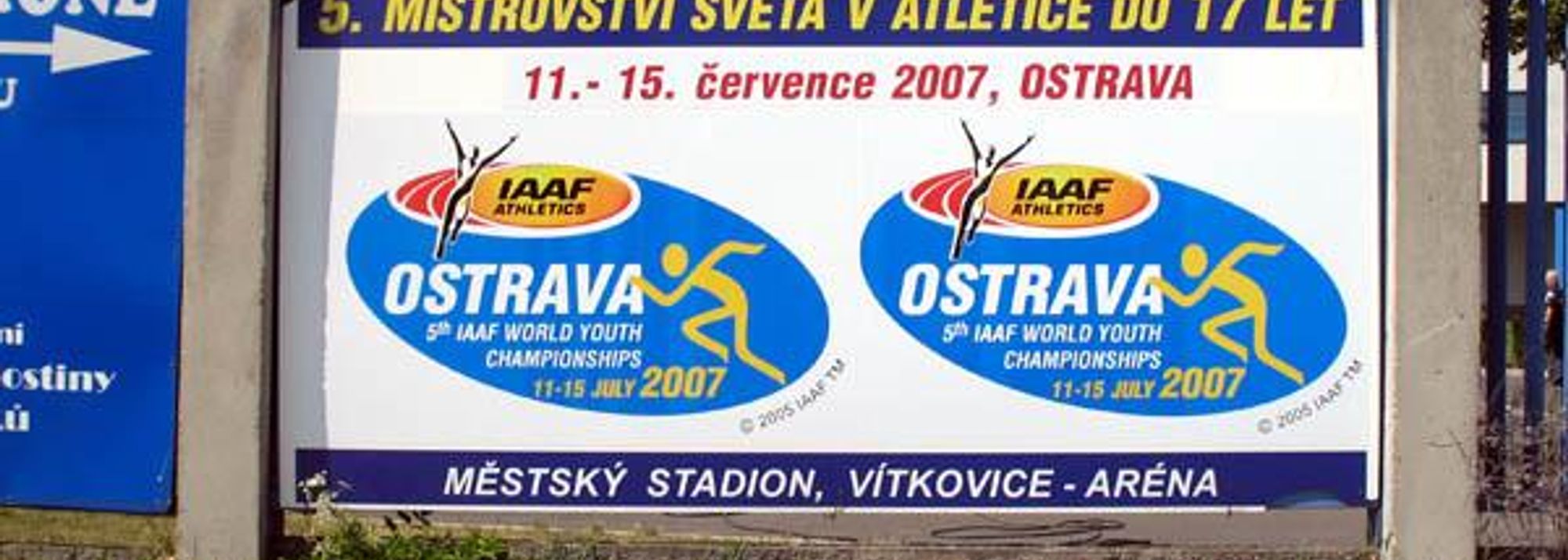A billboard for the IAAF World Youth Championships (© Bob Ramsak)
Ostrava, Czech RepublicWith just 13 days to go before the start of the 5th IAAF World Youth Championships, this sprawling eastern Czech city of 300,000 is already anxiously awaiting to welcome the sport’s future stars.
While best known in recent years for its annual Golden Spike Grand Prix meeting, where last night legendary Haile Gebrselassie set the one hour World record in front of a capacity crowd, Ostrava has a rich athletics history dating back to the glory days of Olympic legend Emil Zatopek.
Unparalleled on the track during his time, Zatopek set two of his 10,000m World records in Ostrava, both in 1949, and a little more than two decades later, the city’s Mitrovice Stadium witnessed history in the sprints as well. In 1973, East German Renate Stecher became the first woman to dip under the 11 second barrier with her 10.9 performance and two years later, Cuban Silvio Leonard equalled the men’s record of 9.9. In 1976, Cuban legend Alberto Juantorena took a 400/800m double here, less than two months before repeating the feat at the Montreal Olympic Games.
Other athletics luminaries to have competed here include Valeriy Borzov, Helena Fibingerova, Irina Szewinska, Rosemarie Ackermann, Marita Koch, Ana Quirot, Jarmila Kratochvílová, and Sergey Bubka.
While the city’s contribution to athletics has been notable, Ostrava, the country’s third largest city, is also known as an all-around sporting centre, the home to two football clubs and a hockey team, and the birthplace of former world tennis No. 1 Ivan lendl. In recent years the Moravian capital has steadily transformed itself from its previous reputation as an industrial centre to a thriving cultural and economic hub. Indeed, few cities in the Czech Republic have witnessed as rapid a change as has transpired here.
Located in the northeastern tip of the country, the city lies at an important crossroads, just 15 kilometres from the border with Poland and 55 kilometres from Slovakia. Founded in 1267, the city grew from a small provincial settlement to a major industrial centre by the end of the 19th Century. The city’s old centre, along with dozens of hotels, restaurants and shops, has been renovated, a facelift that surprised even the city’s residents, many of whom saw for the first time their city’s charming examples of 19th Century architecture.
The Stodolní Street district is particularly popular among visitors. With more than 80 restaurants, pubs and clubs, the area provides a wide international culinary sampling, from Irish and Italian to Caribbean and Czech. For enthusiasts of culture, the city boasts four major theatres - one is named for the famed Czech romantic composer Antonin Dvorak - and more than two dozen galleries and museums, offering a fine collection of local, national and international works of art. A must visit is the 13th Century Silesian-Ostrava Castle, recently renovated and among the most popular destinations with visitors.
And of particular interest - and good fortune! - for those visiting to watch and support the athletics stars of tomorrow is the city’s annual Colours of Ostrava Festival, an eclectic collection of national and international musical acts which this year coincides with the IAAF World Youth Championships.
Bob Ramsak for the IAAF



